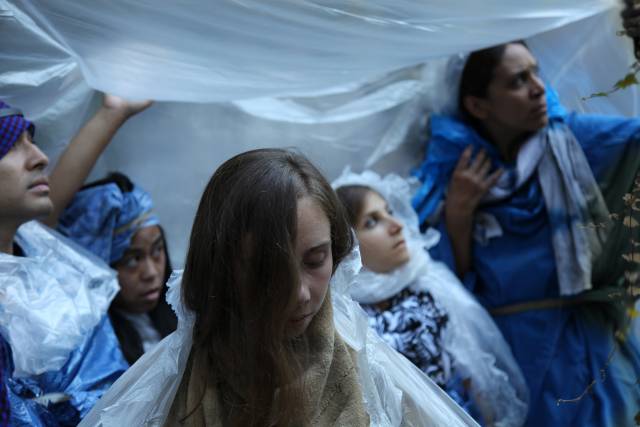

At times literally incomprehensible, but consistently engrossing, Chase: What Matters Most? is the utterly fascinating new play by the award-winning ANIMALS performance group commissioned by and currently presented at Dixon Place through October 31st. This is the kind of theater that is essentially un-reviewable, as it is made to be experienced first-hand. This can, perhaps, be said of most theater, but the ANIMALS performance group is emerging as an ensemble that reliably offers up visceral and pleasantly absurd work that takes full advantage of the tools inherent in live theater. Their work “uses dance, video, puppetry, interactive technology and craft objects to create moments of surprise, irreverence and incongruity that disrupt the perceived stability of social beliefs and attitudes.” They are recipients of the Tom Murrin Performance Award (The Tommy) for “Emerging New Artists” presented by Dixon Place.
The apocalyptic world of Chase: What Matters Most? is expressed in the makeshift set, assembled from bits of fabric held up with a line of carefully strung binder clips and other various relics of a degenerated corporate culture. The venue is haphazardly draped in bright blue plastic tarps, including the audience chairs, which led to an enjoyable crinkly soundtrack to the event as guests shifted in their seats throughout the performance. These ambient sounds blend with the production’s inventive sound design, featuring musical office supplies (synth staplers, hole punch, scissors, etc.) and a haunting series of songs.

The play follows six low-level employees, all named Chase, who work at an anonymous bank and refuse to take the apocalypse seriously. The first character we meet is played virtuosically by ANIMALS core member, Nikki Calonge, a rigorous performer with intense physical commitment. Her striking entrance sets an impressive precedent, but as the sequence of actions is repeated with each successive entrance, the ritual becomes less interesting and more routine. This may be intentional, as this is a particularly tedious depiction of post-apocalyptic life. Entrances and revelations play a key role throughout this piece. Zoë Geltman offers comedic relief, as her character is introduced as a disembodied voice and she later emerges from a pile of brown paper where she has been hiding in plain sight. Eva Peskin makes a surprising entrance that is simultaneously silly and very eerie.
The action is sometimes set in darkness. Some characters speak in strange languages that only make momentary sense, others speak in plain English, but with similarly unintelligible results. While the play is filled with moments that are perplexing, chaotic and incongruous, the production feels extremely purposeful. Every sensory element felt like a potentially intentional choice, including the chilly temperature in the theater which perfectly set the scene for the ice-age environment inhabited by the characters. The production features strong costumes by Bobby Andres with Rosie Rittenberry, which humorously embody a post-apocalyptic corporate dress code integrating office supplies for flare. Visually, the play is a beautiful mess that is gradually pulled apart to make way for the metaphysical journey of the characters.